-
A long-standing challenge in nuclear physics research has been the exploration of nuclei at the limits of existence. One extreme region is that of high mass and charge, the superheavy elements (SHEs). Superheavy nuclei should fission instantaneously due to the Coulomb repulsion between protons. However, shell effects lead to additional binding and create a sizable barrier against fission[1–3]. A large shell correction was also predicted to be responsible for extra stability gained by nuclei around
$ A\!\thicksim\!252 $ [4] where orbitals originating from next spherical shell closures are brought down by deformation in close vicinity of the$Z\! \thicksim \!100$ and$ N\!\thicksim \!152$ Fermi surface. Since the observation of a highly collective rotational band in 254No[5], proof of shell stabilization was found in a few of its even-even[6–14] and odd-A[15–19] neighbors with large ground-state deformation. While it is known that these mid-shell nuclei gain additional binding due to new shell gaps that open up at finite deformation, it is not clear how the rotational force would affect the fission barrier which arises from shell effects. Spectroscopy of heavy actinide nuclei to high spin states could provide valuable information on the excitation and angular momentum dependence of the fission barrier and test the pervasiveness of shell effects on stability of the metastable liquid drop systems, knowledge of which, is essential for understanding the production mechanism of SHEs. On the other hand, as shape stability is a result of competition among several deformation degrees of freedom, it would be interesting to see whether multipole interactions of the orbitals that are active around the Fermi surface give rise to certain exotic nuclear shapes. An idea was proposed long time ago[20] and reanalyzed later[21] in terms of possible presence of the pyramid-like (tetrahedral) shapes in nuclei with the conclusion that extremely strong nuclear shell effects leading to a tetrahedral symmetry may exist in nature on a sub-atomic level. More recently, it was suggested in Ref. [22], based on the Reflection Asymmetric Shell Model calculations on nuclei from Cm to Hs, that the above-mentioned exotic shape may manifest itself in the very heavy mass region through the first order nonaxial-octupole$ Y_{32} $ deformation. Such an effect is expected to be strongest at$ Z\! = \! 98 $ . Indeed, low-lying$ 2^{-} $ states have been identified in a few even-even nuclei with corresponding Z and N. Systematics of$ 2^{-} $ bands up to high-spin states could test predictions for nuclei subject to non-axial octupole correlations, and provide insight on the delicate interplay between various degrees of freedom under rotational stress. Overall, detailed$ \gamma $ spectroscopy studies on heavy actinide nuclei can guide one towards optimal conditions for further spectroscopic investigations of the heaviest nuclei and provide an excellent testing ground for competing effective interactions used nowadays in the description of nuclear structure properties. Progress on both sides will lead to an improved understanding of various correlations and effects including self-organization of single-particle states, pairing, subshell gaps, and shapes of the underlying nuclear force. -
The theoretical analysis in the present work utilizes experimental data from Argonne National Lab obtained via inelastic/transfer reactions with a 208Pb beam impinging on a 249Cf target. The major aim of the experiment was to investigate structure properties of neutron-rich Cf, among which 248Cf was produced by the 1-n pick-up reaction. The experimental setup, analysis and results that are presented in this section will be published separately by the experimental collaboration. Specific selected results and discussion pertinent to the theoretical interpretation that is the focus of this work are highlighted and referenced in this section.
Fig. 1 presents sample spectra of the
$ 2^{-} $ bands of 248Cf from Ref. [23]. The experimental assignment of the pair of bands to 248Cf was based on the presence of Cf characteristic K X-rays together with the 778.9 and 1 422.6 keV ground-state transition in 209Pb. Connection of observed structures to previously known levels relied on coincidence relations and spin fitting, which was first introduced by Wu[24] and then applied in Refs. [25-26] for either spin determination or extrapolation of band head excitation energies. As shown in Fig. 2 which takes one of the bands for example, values of initial spin proposed for the first unambiguous transition (174.2 keV) were tested against the experimental points using a rotational model expression. The reduced$ \chi^{2} $ obtained from these fits are plotted against corresponding spin assumptions (Inset of Fig. 2). A clear preference of$ I_{\rm{init}}\! = \!8 $ is indicated. The optimal spin fit, when extrapolated to lower spins, yields next two transition energies within 2 keV of the previously known$ 6^{-} $ $ \rightarrow $ $ 4^{-} $ $ \rightarrow $ $ 2^{-} $ cascade of a$ 2^{-} $ band. This, together with a few observed gamma-rays deexciting the$ 2^{-} $ band, indicates the same identity for the observed cascade. The new structures were thus treated as the high-spin part of$ K^{\pi} \! = \! 2^{-} $ band. The ordering of new gamma-rays in the cascade relied on energies as well as on the relative intensities of the transitions. The spin and parity of the new states were based on assignment of low-spin part in earlier work and assumed that the cascade transitions are of stretched-E2 character. No inter-band transitions were identified, though evidence existed that there was weak coincidence between the signature partners. For both branches, the gamma-ray flux tended to stay in-band and decay via 550.4 keV E1 transition to the$ 2^{+} $ member of the ground-state band; Strength of out-of-band decay was observed to drop fast with increasing spin.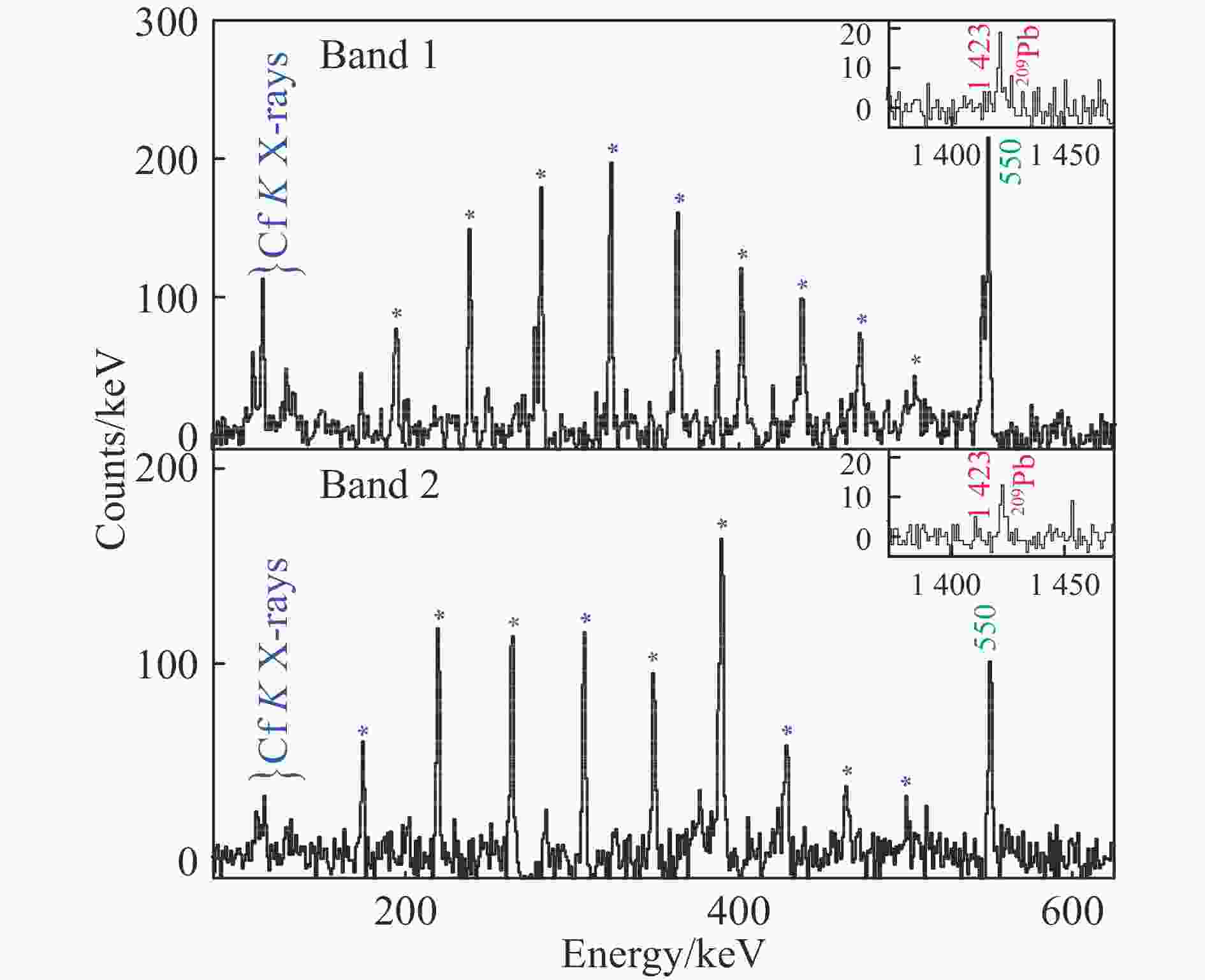
Figure 1. (color online)Representative coincidence spectra for band 1 and 2, Cross-coincident transitions from projectile-like binary reaction partners are shown in the inset(from Ref. [23]).
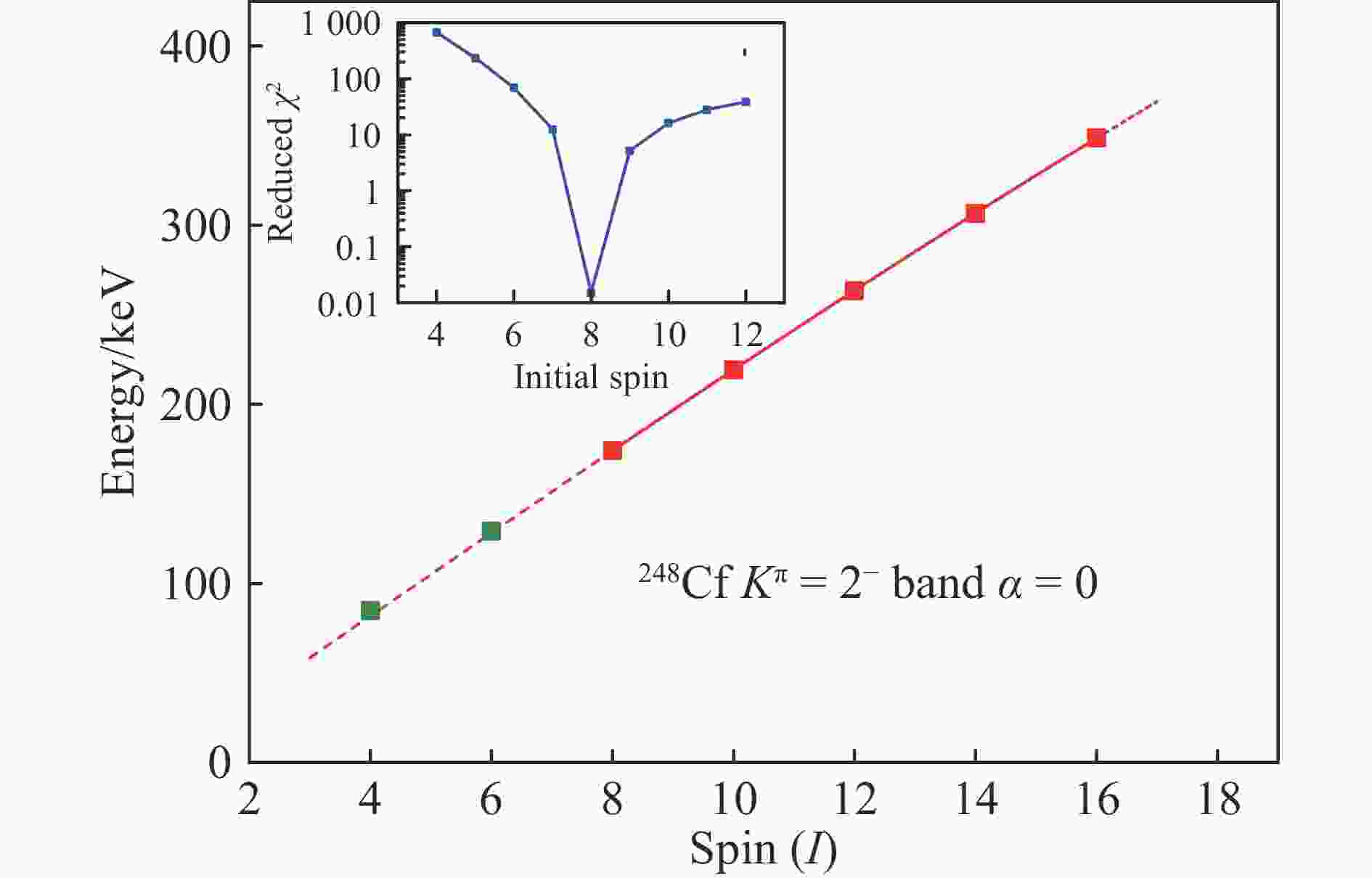
Figure 2. (color online)Rotational model fit to experimental transition energies. Energies of the two lowest transitions are indicated in green dots. The inset shows reduced
$\chi^{2}$ of the fits as a function of the initial spin of first unambiguous transition (from Ref. [23]). -
The signature partners of the
$ 2^{-} $ band were observed with similar intensity. The odd and even branches were traced to spin$ 25{\hbar} $ and$ 24{\hbar} $ respectively, implying that rotation can compete against fission at least to corresponding spins for the configuration. The experimental alignment for the negative parity bands extracted is given in Fig. 3, together with the ground state band. The alignment of the$ K^{\pi}\! = \!2^{-} $ band is seen to build up smoothly and appears to saturate at a rotational frequency$ \approx $ 0.17 MeV. Over the experimentally covered frequency range, neither sequence reaches$ 3{\hbar} $ as expected for the alignment of an octupole phonon. This renders the character of the band puzzling.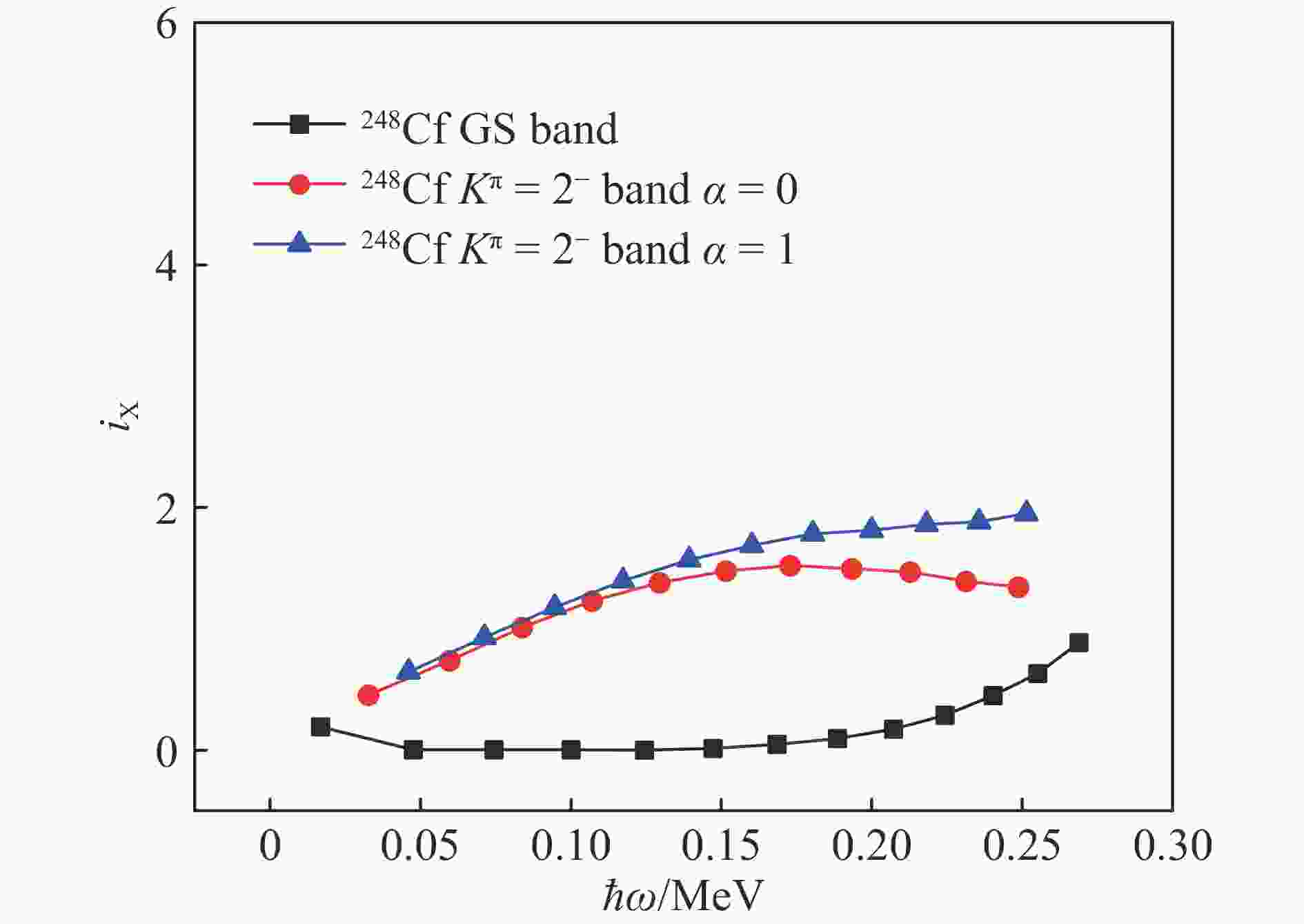
Figure 3. (color online)Angular momentum alignment for ground-state and octupole band in 248Cf calculated using fitted Harris parameters(from Ref. [23]).
It was suggested, in an earlier 249Cf(d, t)248Cf experiment[27], that the
$ 2^{-} $ state at 593 keV has both two-quasineutron$ \lbrace $ 9/2[734], 5/2[622]$ \rbrace $ and phonon components and the major component for the octupole phonon is the two-quasiproton$ \lbrace $ 7/2[633], 3/2[521]$ \rbrace $ configuration. One explanation for the alignment behavior is that the$ 2^{-} $ band loses its phonon character rapidly when rotation is imposed. This can account for the low alignment maximum where the phonon may be broken before it can fully align. Under such assumption, the band would exhibit characteristics as expected for the corresponding two quasi-particle configuration. Level spacing and decay pattern for the presumed$ \nu[734]9/2^{-}\otimes\nu[622]5/2^{+} $ and$ \pi[521]3/2^{-}\otimes \pi[633]7/2^{+} $ bands are therefore investigated. Experimentally, both neutron$ [734]9/2^{-} $ and$ [622]5/2^{+} $ bands have been observed in the neighboring nucleus 249Cf to high spin states. The information for the two proton configuration bands is limited. Only a few low-lying states exist in literature for either configuration[28]. Regarding the decay pattern, B(M1)/B(E2) ratios for both two-quasiparticle configurations are desired. Since neither$ \pi[521]3/2^{-}\otimes\pi[633]7/2^{+} $ nor$ \nu[734]9/2^{-}\otimes \nu[622]5/2^{+} $ configuration band is experimentally available, theoretical values are obtained instead. The resulting branching ratios as deduced from theoretical B(M1)/B(E2) is shown in Fig. 4. It is clear that the proton configuration is highly unlikely as this would lead to stronger observed$ \varDelta I = 1 $ cascade transitions than E2 crossovers. A pure$ \nu[734]9/2^{-} $ $ \otimes $ $ \nu[622]5/2^{+} $ configuration is also not quite probable. The signature partners are much more weakly interacting as opposed to quasineutron bands with similar T(M1+E2)/T(E2) as the theoretical values. If the reduced mutual interaction between the partner bands is due to mixing of other two-quasiparticle states, one may need to answer quantitatively whether such mixing arises from the breaking of an octupole phonon, and why the phonon is vulnerable to rotation in this specific nucleus. A clarification of these issues requires a detailed QRPA calculation which is not available at this point.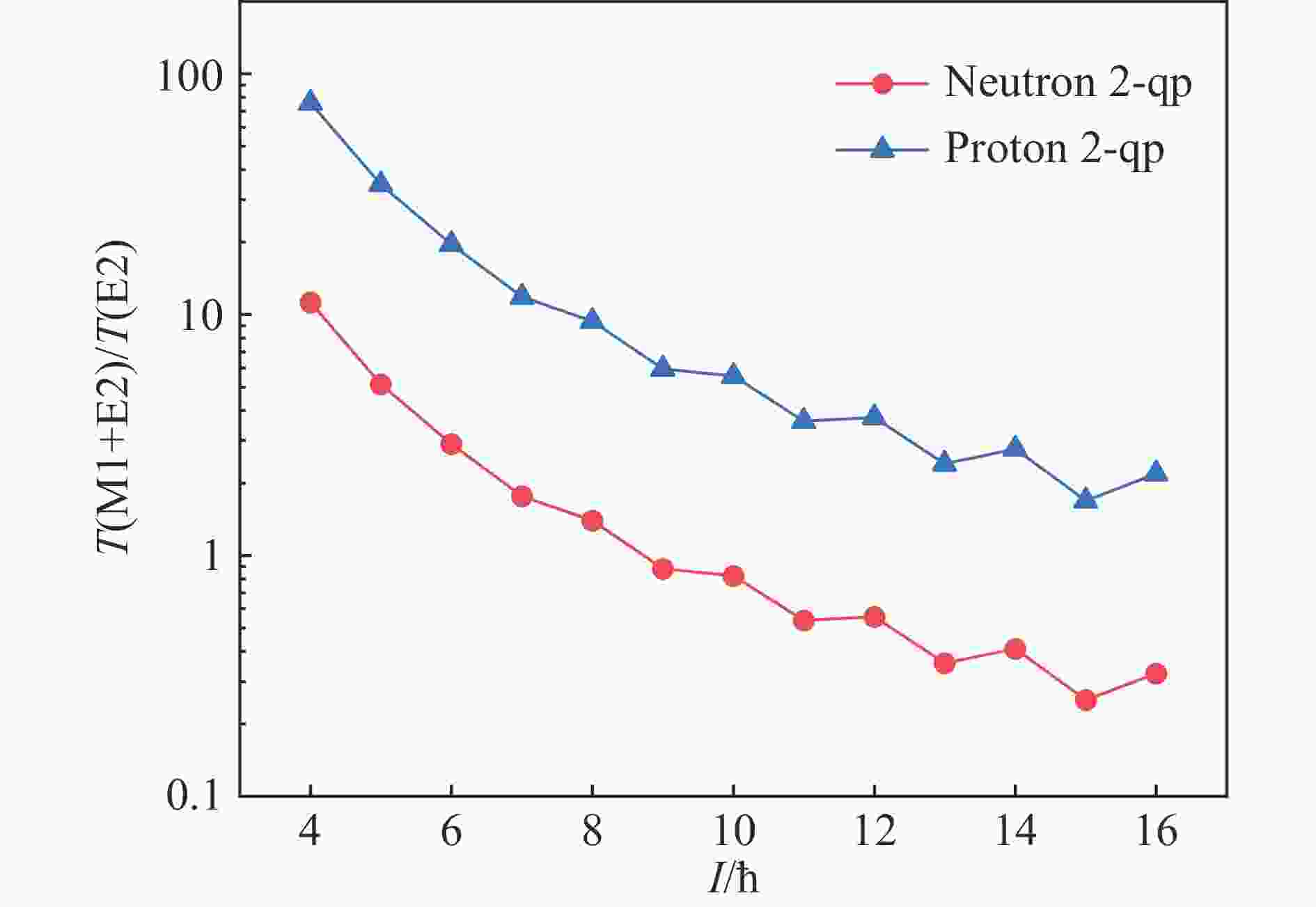
Figure 4. (color online)M1/E2 branching ratios under pure 2-qp
$\lbrace$ 7/2[633], 3/2[521]$\rbrace$ 2– and 2-qn$\lbrace$ 9/2[734],5/2[622]$\rbrace$ 2– assumptions.It is also possible that the deviation of characteristics from the pure two quasiparticle band arises from some other effects. Chen et al.[22] suggest nuclei in the mass-250 region with proton number from
$ 96\!\thicksim\!108 $ may exhibit strong$ Y_{32} $ correlations and, the correlation is strongest at$ Z \! = \! 98 $ due to near-degeneracy of the proton 7/2[633] and 3/2[521] orbitals which increases octuple collectivity and leads to pronounced minimum in$ 2^{-} $ energy. Theoretical intraband B(M1)/B(E2) and interband B(E1)/B(E2) ratios under pure collective$ Y_{20}+Y_{32} $ assumption are displayed in Fig. 5. The B(M1)/B(E2) drops to ~50% the initial value over few spins and are nearly constant after spin 8. The derived M1/E2 branching ratios are two orders of magnitude lower as compared to the hypothesized 2-qn configuration. The B(E1)/B(E2) values, on the other hand, increase steadily with spin and are of the same order as those reported for octupole bands in neighboring isotopes, either of which, is in contrast to the experimentally observed decay pattern. The underlying physics could perhaps be explained by evoking the two-band mixing scenario. Mixing with a higher lying phonon band pushes the 2-qp band down and results in distinctive characteristics for the observed band. It is worth noting that while the$ 2^{-} $ band in 248Cf is more characteristic of a quasiparticle configuration, we find, a few other nuclei in this mass region do exhibit features as expected for a tetrahedral shape by theory, both in level energy spacings and in electromagnetic properties.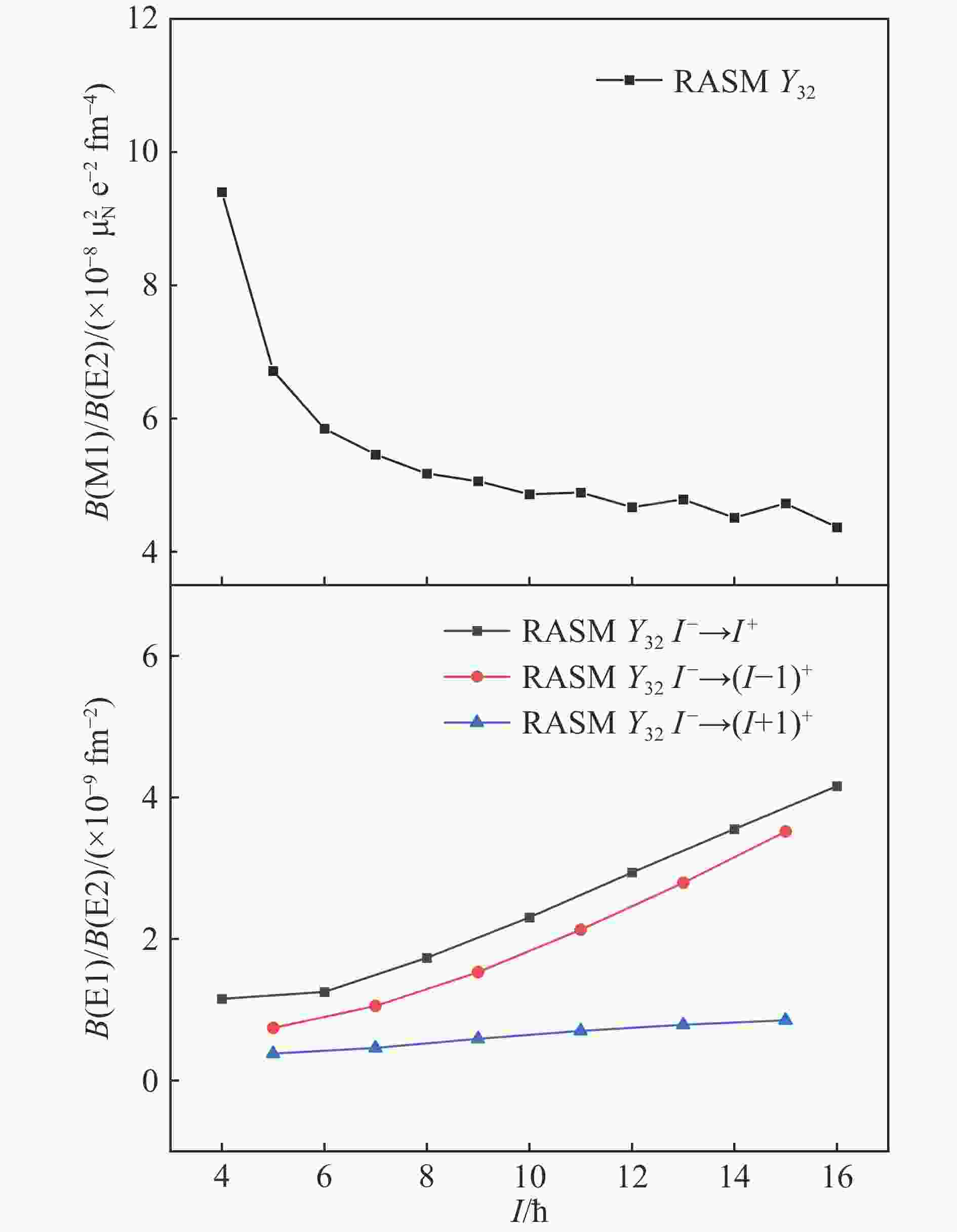
Figure 5. (color online)RASM predicted B(M1)/B(E2) and B(E1)/B(E2) ratios for pure collective
$Y_{32}$ band.The
$ 2^{-} $ level energies are rather constant over a wide span of Z for$ N\! = \! 150 $ isotones, except in 248Cf, where there is a 34% dip at an excitation energy of 593 keV. It is interesting to note that the singular drop of the$ 2^{-} $ energy is accompanied by a transition in character of the corresponding band. Standard BCS approach requires energy greater than two times the pairing gap, i.e. approximately 1 MeV as derived from experimental odd-even mass difference in this case, for a two-quasineutron excitation. Venkova et al.[29] proposed, based on systematics of g-s crossing in Yb nuclei, that static pair field is absent in the heavy Yb isotopes, where pair fluctuations smear an already rather smooth pairing phase transition. This finding is of interest for neutron-rich Cf where a similar weak pairing regime seems to be present. One plausible explanation for the suppressed collectivity is the weakening of static neutron pairing near$ N\! = \!152 $ subshell gap, which indicates strong fluctuations and mixing of configurations. Consequently, the nucleus exists with considerable probability in the normal phase already at rather low excitation energy. It is not clear at this point what the role of neutron-proton interaction is on the correlations of the 248Cf nucleus, recent results presented by Hinohara et al.[30-31] seem to highlight however, the importance of mixing of the neutron and proton pairing rotational NG modes in accounting for the ground state properties of open-shell even-even nuclei. -
A theoretical analysis of
$ 2^{-} $ bands that have been experimentally identified in 248Cf up to spin$ 25{\hbar} $ [23] was undertaken in this work. Alignment properties and decay pattern for the newly observed structure were investigated. Based on RASM calculations, the decay features for the band can be qualitatively accounted for within a quasiparticle phonon admixture picture, i.e. quasiparticle nature forbids decay to ground-state band, non-axial octupole phonon shifts the signature partners in energy and diminishes mutual interaction. The observed coexisting phase is tentatively attributed to weak neutron pairing in the proximity of 152 deformed shell gap. Investigation of the impact of neutron-proton interaction on the evolution of octupole collectivity in the isotones is on the way.
-
摘要: 本工作给出了对248Cf中
$2^{-}$ 带的理论分析。这条带在实验中被观测到自旋$25{\hbar}$ 和激发能高于4 MeV,因此该原子核在相应组态下裂变位垒至少持续到此角动量和激发能。就顺排性质和衰变特征对实验$2^{-}$ 带背后的物理机制进行了探讨。二准中子,二准质子以及非轴对称八极形变(基于反射不对称壳模型)内禀结构的不同假设通过电磁跃迁性质进行评估。结果显示,实验$2^{-}$ 带的谱学特性在粒子-声子混合图像下能得到较好的解释:准粒子阻碍了向基带的跃迁,非轴对称八极声子增大了旋称伙伴带的能级劈裂, 减弱了带间相互作用。该核低激发态展现的超导和正常相共存被尝试性地归因于中子152亚壳附近对相互作用的减弱。Abstract: An independent theoretical analysis is presented for the 2– band in 248Cf, which has been identified to spin$25{\hbar}$ and excitation energy$\geqslant$ 4 MeV, implying the fission barrier persists at least up to that angular momentum and excitation for the configuration. The underlying physics for the experimentally observed band is discussed in terms of alignment properties and decay pattern. Different scenarios for assumptions about intrinsic configuration are assessed with transition rates analysis. It turns out that only by invoking a particle-phonon mixing picture can the decay characteristics of the pair of bands be well accounted for, i.e. quasiparticle nature forbids decay to ground-state band, non-axial octupole phonon shifts the signature partners in energy and diminishes mutual interaction. The coexisting normal and superconducting phases are tentatively attributed to weak neutron pairing in the proximity of 152 deformed shell gap.-
Key words:
- shell-stabilization /
- high-spin /
- tetrahedral symmetry /
- particle-phonon mixing
-
Figure 1. (color online)Representative coincidence spectra for band 1 and 2, Cross-coincident transitions from projectile-like binary reaction partners are shown in the inset(from Ref. [23]).
Figure 2. (color online)Rotational model fit to experimental transition energies. Energies of the two lowest transitions are indicated in green dots. The inset shows reduced
$\chi^{2}$ of the fits as a function of the initial spin of first unambiguous transition (from Ref. [23]).Figure 3. (color online)Angular momentum alignment for ground-state and octupole band in 248Cf calculated using fitted Harris parameters(from Ref. [23]).
-
[1] SOBICZEWSKI A. Phys Part Nucl, 1994, 112, 162501: 119. [2] MÖLLER P, NIX J. J Phys G, 1994, 20: 1681. doi: 10.1088/0954-3899/20/11/003 [3] SMOLANCZUK R, SKALSKI J, SOBICZEWSKI A, et al. Phys Rev C, 1995, 52: 1871. doi: 10.1103/PhysRevC.52.1871 [4] PATYK Z, SOBICZEWSKI A. Nucl Phys A, 1991, 533: 132. doi: 10.1016/0375-9474(91)90823-O [5] REITER P, KHOO T L, LISTER C J, et al. Phys Rev Lett, 1999, 82: 3. doi: 10.1103/PhysRevLett.82.509 [6] LEPPÄNEN A, UUSITALO J, GREENLEES P T, et al. Eur Phys J A, 2006, 28: 301. doi: 10.1140/epja/i2006-10056-2 [7] BASTIN J, HERZBERG R D, BUTLER P A , et al. Phys Rev C, 2006, 73: 024308. doi: 10.1103/PhysRevC.73.024308 [8] ROBINSON A, KHOO T L, AHMAD I, et al. Phys Rev C, 2008, 78: 034308. doi: 10.1103/PhysRevC.78.034308 [9] GREENLEES P, HERZBERG R D,KETELHUT S, et al. Phys Rev C, 2008, 78: 021303(R). doi: 10.1103/PhysRevC.78.021303 [10] SULIGNANO B, THEISEN C, DELAROCHE J P, et al. Phys Rev C, 2012, 86: 044318. doi: 10.1103/PhysRevC.86.044318 [11] GREENLEES P, RUBERT J, PIOT J, et al. Phys Rev Lett, 2012, 109: 012501. doi: 10.1103/PhysRevLett.109.012501 [12] PIOT J, GALL B J P, DORVAUX O, et al. Phys Rev C, 2012, 85: 041301(R). doi: 10.1103/PhysRevC.85.041301 [13] DAVID H, CHEN J, SEWERYNIAK D, et al. Phys Rev Lett, 2015, 115: 132502. doi: 10.1103/PhysRevLett.115.132502 [14] KONKI J, SULIGNANO B, GREENLEES P T, et al. Phys Rev C, 2018, 97: 024306. doi: 10.1103/PhysRevC.97.024306 [15] REITER P, KHOO T L, AHMAD I, et al. Phys Rev Lett, 2005, 95: 032501. doi: 10.1103/PhysRevLett.95.032501 [16] CHATILLON A, THEISEN C, BOUCHEZ E, et al. Phys Rev Lett, 2007, 98: 132503. doi: 10.1103/PhysRevLett.98.132503 [17] HERZBERG R, MOON S, EECKHAUDT S, et al. Eur Phys J A, 2009, 42: 333. doi: 10.1140/epja/i2009-10855-9 [18] KETELHUT S, GREENLEES P T, ACKERMANN D, et al. Phys Rev Lett, 2009, 102: 212501. doi: 10.1103/PhysRevLett.102.212501 [19] RISSANEN J, CLARK R M, GREGORICH K E, et al. Phys Rev C, 2013, 88: 044313. doi: 10.1103/PhysRevC.88.044313 [20] LI X, DUDEK J. Phys Rev C, 1994, 49: R1250(R). doi: 10.1103/PhysRevC.49.R1250 [21] DUDEK J, GOŹDŹ A, SCHUNCK N, et al. Phys Rev Lett, 2002, 88(25): 252502-1. doi: 10.1103/PhysRevLett.88.252502 [22] CHEN Y, SUN Y, GAO Z. Phys Rev C, 2008, 77: 061305(R). doi: 10.1103/PhysRevC.77.061305 [23] QIU Y. Single-Particle and Collective excitations in N ~ 150 Cm and Cf Nuclei[D]. Lowell: University of Massachusetts Lowell, 2016. [24] WU C S, CHENG L, LIN C Z, et al. Phys Rev C, 1992, 45: 2507. doi: 10.1103/PhysRevC.45.2507 [25] EECKHAUDT S. Spectroscopy in the Transfermium Region: Probing Rotational, Non-yrast and Isomeric Structures in 253, 254No[D]. Jyväskylä: University of Jyväskylä, 2006. [26] KETELHUT S. Rotational Structures and High-K Isomerism in 248, 250Fm[D]. Jyväskylä: University of Jyväskylä, 2010. [27] YATES S, CHASMAN R R, FRIEDMAN A M, et al. Phys Rev C, 1975, 12: 442. doi: 10.1103/PhysRevC.12.442 [28] AHMAD I, KONDEV F G, MOORE E F, et al. Phys Rev C, 2005, 71: 054305. doi: 10.1103/PhysRevC.71.054305 [29] VENKOVA T, GAST W, LIEDER R M, et al. Eur Phys J A, 2005, 26: 19. doi: 10.1140/epja/i2005-10132-1 [30] HINOHARA N. Phys Rev C, 2015, 92: 034321. doi: 10.1103/PhysRevC.92.034321 [31] HINOHARA N, NAZAREWICZ W. Phys Rev Lett, 2016, 116: 152502. doi: 10.1103/PhysRevLett.116.152502 -









 下载:
下载:






























































 甘公网安备 62010202000723号
甘公网安备 62010202000723号